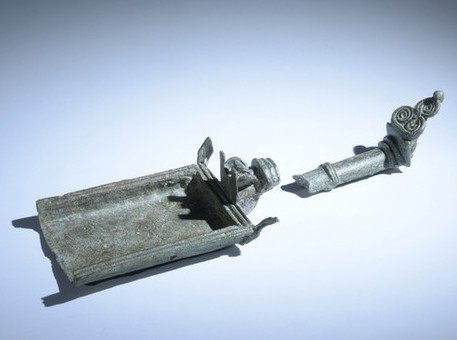Unearthing History: A 2,000-Year-Old Scribe's Tool from the Second Temple Era
An ancient scribe's tool used in the holy rites of the Second Temple was discovered near the Sea of Galilee during an archaeological dig.
 The scribe's tool after cleaning in the artifact preservation lab (Photo: Israel Antiquities Authority)
The scribe's tool after cleaning in the artifact preservation lab (Photo: Israel Antiquities Authority)During an archaeological excavation conducted by the Israel Antiquities Authority at a construction site for a new hotel near the shores of Migdal by the Sea of Galilee, a decorated bronze scribe's tool and jug were unearthed.
This scribe's tool is one of the sacred implements that served the religious practices of the Second Temple. The priests used it to move incense and coals during the incense offerings.
The term "scribe's tool" originates from the action performed with the coals—enhancing their heat by moving and shaking them. In the Book of Exodus, the scribe's tool is mentioned as a command to Moses regarding the altar: "You shall make the altar... and its pots to remove its ashes, and shovels and basins and forks and fire pans". (Exodus 27:1-3).
 המחתה לאחר ניקוי במעבדות הטיפול בממצאים של רשות העתיקות (צילום: רשות העתיקות)
המחתה לאחר ניקוי במעבדות הטיפול בממצאים של רשות העתיקות (צילום: רשות העתיקות)According to Dina Avshalom-Gorni, director of the excavation on behalf of the Israel Antiquities Authority: "The scribe's tool we found, dating back to the 2nd century CE, joins a mere 10 others known from the Second Temple period in the country. Initially, researchers believed it served solely as a ritual object for handling coals and incense used in ceremonial rites. Over the years, as scribe's tools lacking religious context have been discovered, it seems they also functioned as everyday utility tools. The tool and jug were found on a stone floor within a storage room adjacent to Migdal's dock. These items might have been preserved as valuable possessions for a Jewish family from Migdal or used daily."
In extensive excavations at the site in recent years, a Jewish settlement from the Second Temple period has been unveiled in Migdal, revealing homes, ritual baths, streets, a marketplace, industrial facilities, and a synagogue adorned with colorful plastered walls. At the center of the reading room, a square stone, depicting the Temple in Jerusalem, features a seven-branched menorah on one side.
Eiyad Basharat, an archaeologist with the Israel Antiquities Authority, shared, "The volunteers were incredibly excited. They were amazed that these utensils had waited just beneath the surface for 2,000 years. Even seasoned diggers like us were thrilled: it's not every day that such rare and well-preserved finds are uncovered."
Located near the Migdal settlement by the northern Sea of Galilee, the site is open to visitors and offers a tour of the 2,000-year-old settlement unearthed in the excavations.

